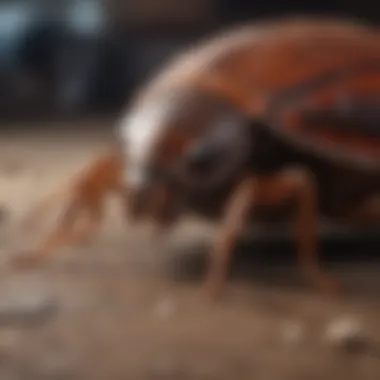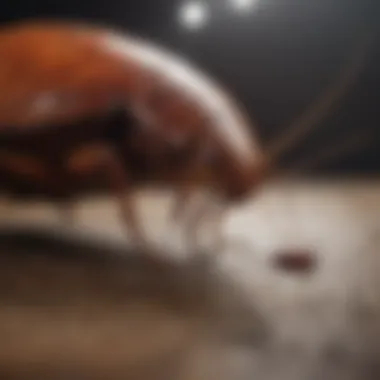Effective Strategies to Eliminate Cockroaches in Vehicles


Intro
Animal Overview
Common Names
Cockroaches are often referred to as roaches. The most common species found in vehicles include the German cockroach, American cockroach, and Oriental cockroach. Each of these species has its own unique characteristics but possess similar habits that lead them into cars.
Scientific Classification
Cockroaches belong to the order Blattodea. They are classified into various families, with Blattidae, Ectobiidae, and Blaberidae being some of the prominent ones. The German cockroach, for instance, is known as Blattella germanica, while the American cockroach is termed Periplaneta americana.
Geographic Range
Cockroaches are widespread and can be found in most parts of the world. They prefer warm, moist environments, which allow them to thrive. This adaptability has led them to become common in urban areas, especially in places where waste and food are present.
Behavior and Social Structure
Social Behavior
Cockroaches are primarily nocturnal creatures, often emerging at night to search for food. They exhibit a degree of social behavior, as they tend to gather in groups. This gregariousness can increase the likelihood of infestations in vehicles, especially if they find suitable conditions.
Communication
Cockroaches communicate through chemical signals known as pheromones. These signals help them identify food sources, alert others about danger, and locate mates. Their acute sense of smell makes them highly sensitive to environmental changes.
Mating and Reproduction
Understanding their reproductive habits is important for control. Cockroaches reproduce quickly, with females capable of laying dozens of eggs at a time. This leads to rapid population growth if left unchecked.
Habitat and Ecosystem
Natural Habitat
In nature, cockroaches prefer dark and damp environments. They can often be found under leaves, in decaying wood, and in other organic matter. In vehicles, they can hide under seats, dashboards, and in storage compartments.
Food Sources and Diet
Cockroaches are omnivorous, feeding on various organic materials. They are known to consume food scraps, paper, glue, and even grease, making vehicles with leftover food particularly attractive to them.
Role in Ecosystem
In their natural habitat, cockroaches play a role in breaking down organic matter. However, in a vehicle, their presence is usually undesirable. Therefore, understanding their behavior and habitat needs is crucial for effective eradication.
Cockroaches can invade vehicles easily because they are naturally drawn to food, dark spaces, and warmth. Taking preventive measures is essential for a cockroach-free vehicle.
Understanding Cockroaches
Understanding cockroaches is a crucial aspect of effectively handling infestations within vehicles. This section provides insight into the biology, behavior, and the reasons that make vehicles attractive to these pests. Knowing the specifics allows car owners to make well-informed decisions when it comes to prevention and treatment. Cockroaches are resilient insects that adapt easily to various environments, including our cars. Recognizing their characteristics helps in tackling infestations from a knowledgeable standpoint.
Biology of Cockroaches
Life Cycle and Reproduction
The life cycle of cockroaches involves three primary stages: egg, nymph, and adult. Females can produce numerous eggs, often resulting in rapid population growth. This trait is significant as it leads to quicker re-infestations if not managed properly. Cockroaches reproduce quickly, making early intervention critical for vehicle owners.
Key characteristic: A female cockroach can lay up to 40 eggs in a single egg case, which can transform at an alarming rate into an overwhelming number of adult cockroaches.
The unique feature of the life cycle is that nymphs resemble smaller adults and can begin reproducing within weeks. This means that a small infestation can lead to a significant problem in a very short period.
Cockroach Species Common in Vehicles
Several species of cockroaches can infest vehicles, but the German cockroach and the American cockroach are the most common. Understanding these species offers insight into your specific problem. The German cockroach is smaller and often found in large numbers. In contrast, the American cockroach is larger and tends to inhabit more open areas.
Key characteristic: The German cockroach typically prefers warm, humid environments, while the American cockroach can thrive in varied conditions.
This knowledge helps vehicle owners identify which species they are dealing with, enabling them to choose appropriate treatment methods.


Behavioral Patterns
Cockroaches are nocturnal, often hiding during the day and emerging at night to search for food. This behavior can make them difficult to spot until populations are large. They are attracted to food residues and organic materials, which are often found in vehicles.
Key characteristic: Their nocturnal nature contributes to their elusive presence, complicating detection and removal efforts.
Understanding their behavioral patterns allows vehicle owners to adjust their cleaning habits and address potential food sources effectively.
Why Cockroaches Choose Cars
Attractiveness of Vehicles as Habitats
Vehicles can be appealing habitats for cockroaches for several reasons. The sheltered spaces provide cover from predators and environmental conditions. Additionally, spilled food and trash in cars create a food source. This environment mimics the conditions cockroaches seek for survival, contributing to the propensity for infestations.
Key characteristic: The combination of shelter and food availability makes vehicles ideal for cockroaches.
Vehicles offer an undisrupted space, making it easier for cockroaches to thrive unnoticed. Recognizing these factors can help owners take preventive actions to minimize such attractions.
Contributing Factors to Infestation
Several contributing factors lead to cockroach infestations in vehicles. Poor hygiene practices, like leaving food crumbs and wrappers, significantly attract these pests. Additionally, inadequate sealing of doors or windows can give them easy access to vehicles.
Key characteristic: Neglected cleaning routines can create a breeding ground for cockroaches.
Understanding these underlying causes is essential for forming effective prevention strategies. By tackling cleanliness and sealing entry points, vehicle owners can reduce the likelihood of infestations.
Recognizing an Infestation
Recognizing an infestation is a critical step in managing cockroach problems in vehicles. Early detection can greatly reduce the extent of damage and discomfort caused by these pests. Understanding how to identify an infestation allows vehicle owners to take timely action, preventing a larger, more complicated problem from developing.
Signs of Cockroaches in Cars
Visible Sightings
Visible sightings of cockroaches are one of the most immediate indications of an infestation. Regular checks for these pests can helps catch a problem before it escalates. Cockroaches can often be seen scurrying away when lights are turned on or during the day if they are particularly numerous. This visibility provides direct insight into the level of infestation. The main characteristic is their speed and ability to hide quickly.
However, spotting them may not always be possible. Depending on their population, they may hide effectively, making their detection more difficult. This can be seen as an advantage because it gives whomever responsible for the vehicle time to react before the infestation becomes unmanageable. Conversely, if infestation occurs at a high level, it may still be seen as a disadvantage since the problem could be much worse than realized.
Identification of Droppings
Identifying droplets, or cockroach feces, is another tangible sign of infestation. The droppings are usually small, dark, and oval-shaped. Recognizing these droppings can guide vehicle owners to potential nests or hotspots within the car. This method is particularly valuable as it may show the activity level of cockroaches even if they are not currently seen.
These droppings can accumulate in hidden areas, such as under the seats or in corners, which can be easier to overlook. Noticing them reminds vehicle owners to clean those spaces thoroughly. However, relying solely on droppings may be challenging if the infestation is new and small. It requires vigilance to determine the true scale of the issue based on this sign alone.
Unpleasant Odors
Unpleasant odors can also indicate cockroach presence. Many vehicle owners might notice a musty smell throughout the vehicle or a more persistent odor coming from specific areas, such as the trunk or under the seats. The smell often arises from the presence of cockroach waste and decaying bodies. This can lead to immediate concerns about cleanliness.
Recognizing odors as a sign of infestation can be beneficial, as they often serve as an early warning signal. However, tying unpleasant odors directly to cockroaches might not always be accurate. Other possible sources of bad smells could complicate the situation, requiring a comprehensive inspection for confirmation.
Common Hotspots within Vehicles
Under the Seats and Mats
Under the seats and mats is a common hotspot for cockroach infestations. This area provides an ideal hiding space, offering darkness and protection from light. Regular cleaning in these spots can help reduce the likelihood of infestation.
These areas are easily accessible yet often neglected in thorough cleanings. This tendency can lead to a buildup of food particles and debris, enticing cockroaches. The advantage is that these spots can be relatively easy to check and clean. However, if overlooked, they can become breeding grounds.
Engine Compartment
The engine compartment is another area susceptible to infestations. It's not a traditional nesting site, but cockroaches may find refuge in the warmth generated, especially in cooler months. Also, the many components offer various spaces to hide or lay eggs. This makes spaces around wires or rubber grommets particularly attractive.
Monitoring the engine compartment can help minimize potential infestations. However, inspecting this area requires care and knowledge about the car's components to avoid accidental damage. The advantage of checking here is spotting earlier signs of an infestation compared to other areas of the vehicle.
Trunk and Storage Areas
The trunk and other storage areas can collect items or trash, providing food sources for cockroaches. Items left there for long periods allow an easy opportunity for cockroaches to thrive. This can lead to significant infestations if not regularly monitored.


The key characteristic is the high variety of hiding spots and organic material that often becomes accumulated. This reliance on limiting food waste can be beneficial. However, the disadvantage is that these areas may often be disregarded until significant problems arise.
Preventative Measures
Preventative measures are essential for maintaining a cockroach-free vehicle. A proactive approach can effectively reduce the risk of infestations. Keeping cockroaches at bay not only helps maintain the integrity of your vehicle but also promotes a healthier environment for occupants. These measures are often simpler and less costly than treating an existing infestation. Here we will delve into practical actions and strategies you can incorporate into your routine.
Keeping Your Car Clean
Regular Vacuuming Techniques
Regular vacuuming is a core technique in maintaining cleanliness. Vacuuming effectively removes food particles and debris that attract cockroaches. One key characteristic of this method is its straightforward implementation. It does not require special equipment apart from a vacuum cleaner and some diligence. For enhanced results, focus on areas often neglected, such as under the seats, in crevices, and amidst floor mats. This method is beneficial because it provides visible and immediate results. It dissipates potential food resources for these pests. However, the frequency of vacuuming is crucial; it must be done regularly to ensure long-term efficacy.
Proper Food and Trash Disposal
Food waste and improperly disposed trash are prime attractants for cockroaches. The main aspect of proper disposal is ensuring no food residue remains in your vehicle. Keeping snacks and meals outside or in sealed containers will help. This method is a popular choice because it is simple and requires minimal effort. The key feature is its preventative nature; by limiting food sources, you effectively deter infestations. However, the disadvantage can be forgetting to remove items after use, which may be a risk. Consistency is essential to make this strategy effective.
Sealing Entry Points
Inspecting Doors and Windows
Doors and windows are common entry points for cockroaches. Regularly inspecting these areas helps identify possible gaps or cracks. One important characteristic of this inspection routine is its focus on preventive action before infestations develop. This is an effective choice in this article since it addresses potential problems before they escalate. The unique feature lies in the ability to take action early. However, identifying minute gaps may require a keen eye, which might be challenging for some.
Utilizing Weather Stripping
Using weather stripping materials provides a physical barrier against cockroaches. This method can be a popular solution due to its cost-effectiveness and ease of application. The key characteristic is the creation of a seal along doors and windows, greatly minimizing potential entry points. This is beneficial in keeping your vehicle secure from pests. On the downside, this might need periodic checks and replacements as weather stripping materials can wear out over time.
Regular Vehicle Maintenance
Routine Inspections for Infestations
Conducting routine inspections for infestations is crucial for early detection. This aspect centers on checking high-risk areas, even before signs of cockroaches appear. Its key characteristic is its proactive approach to potential infestations. It aids in minimizing long-term setbacks associated with severe infestations. However, checking for pests might seem tedious, especially if no immediate issues are found. Still, it remains a fundamental component of vehicle upkeep.
Keeping the Engine and Undercarriage Clean
A clean engine and undercarriage can significantly deter cockroaches. This area is often neglected, making it a nesting site for pests. One key characteristic of this maintenance strategy is its comprehensive scope. It encompasses not only visible areas but also less accessible parts of the vehicle. This maintenance practice is beneficial for the overall health of the vehicle and pest prevention. However, cleaning the undercarriage may require a professional touch. Regular cleaning schedules are crucial for ensuring cleanliness over time.
Effective Treatment Methods
The presence of cockroaches in vehicles is more than a nuisance. Effective treatment methods are critical for achieving comprehensive control over these pests. These methods can directly reduce infestations and minimize the risk of recurrence. Being aware of various treatment options empowers vehicle owners to make informed decisions. Treatment approaches generally fall into three categories: chemical solutions, natural remedies, and professional services. Each category serves a distinct purpose and has its advantages.
Chemical Solutions
Insecticides and Sprays
Insecticides and sprays are commonly used for treating cockroach infestations in vehicles. These products are formulated to target cockroaches at various life stages. The key characteristic of these chemical agents is their immediate lethal action upon contact or ingestion. Many owners find insecticides appealing for their swift results in ridding vehicles of cockroaches.
A unique feature of many insecticides is their formulation, which often includes a combination of active ingredients. This combination can enhance effectiveness against resistant strains of cockroaches. However, caution is needed when using these products as they can pose health risks to humans and pets. Proper usage and adherence to guidelines are essential. Consider factors such as ventilation and application areas when deploying insecticides in confined spaces like vehicles.
Applicability of Baits and Traps
Baits and traps serve as another method in the battle against cockroaches. These products contain attractants combined with poisons that cockroaches consume. The primary advantage of using baits is their prolonged effectiveness. Unlike sprays, which have immediate action, baits work gradually. Cockroaches take the bait and die later, often leading to the elimination of entire populations over time.
A notable characteristic of baits is their design and placement. They are often small and discreet, allowing placement in areas where sprays might be impractical. On the downside, placement requires a strategic approach to ensure cockroaches locate the bait. Additionally, baits may be ineffective against heavy infestations where cockroaches may not encounter them. Still, when used correctly, baits can play a crucial role in a comprehensive treatment plan.
Natural Remedies
Essential Oils and Their Efficacy
Natural remedies have gained popularity for those seeking alternatives to chemical treatments. Essential oils, such as peppermint and tea tree oil, are known for their repellent properties. Their key characteristic is their natural origin, making them an appealing choice for eco-conscious car owners. Essential oils can disrupt cockroaches’ sensory perception, deterring them from nesting in vehicles.
A unique feature of these oils is their versatility. They can be combined with water to create sprays or diffused in the vehicle. However, while essential oils may deter cockroaches, they tend to be less effective at causing outright elimination. Hence, they are best used in conjunction with other methods for a comprehensive solution.
Other Natural Repellents
Besides essential oils, other natural repellents can also aid in preventing cockroach infestations. Some household items, such as bay leaves or soap and water solutions, provide non-toxic options. A major advantage of these repellents is their safety for both humans and pets. Many vehicle owners appreciate using materials that do not introduce harmful chemicals.
These natural options, however, have limitations. Their effectiveness varies greatly and may not be suitable for serious infestations. Often, they serve as a preventative measure rather than a treatment. Consequently, these alternatives are best integrated into a broader pest control strategy.


Professional Pest Control Services
Assessment of the Situation
For those overwhelmed by infestations or unsure of the next steps, professional pest control services offer an effective alternative. One of the initial steps taken by professionals is assessing the situation. This assessment includes identifying the extent of the infestation and locality within the vehicle. The key characteristic of this service is the expertise offered, often resulting in a targeted approach to treatment.
With professional help, owners benefit from tailored solutions that are based on informed evaluations. This method helps in deploying the most effective strategies without the guesswork involved in DIY methods. However, reliance on professionals comes with costs, which should be weighed against the solution provided. Being informed about the process can help ease the decision-making process.
Cost-Benefit Analysis of Hiring Professionals
Evaluating the cost-benefit analysis of hiring professional pest control services is crucial. Owners must consider what they are investing compared to the potential gains. Professional services often deliver faster results and comprehensive follow-up options, leading to peace of mind. The key characteristic here is the experience and tools that professionals bring to the table.
As with any service, there are both advantages and disadvantages. The primary disadvantage is the associated cost, which can vary significantly based on the service level and extent of infestation. However, if the infestation is severe, the expense may be justified. Ultimately, weighing the immediate needs against long-term solutions allows a reasoned approach in determining the way to proceed.
Post-Treatment Maintenance
Post-treatment maintenance plays a crucial role in ensuring the effectiveness of cockroach eradication efforts in vehicles. After using chemical treatments, natural remedies, or professional services, it is vital to implement consistent follow-up practices. This will help prevent the resurgence of cockroaches and support long-term control strategies. Focusing on systematic inspections and reinforcing preventative measures can make a significant difference.
Conducting Follow-Up Inspections
Regular follow-up inspections are essential for identifying any recurring issues related to cockroach infestations. These inspections can help pinpoint areas where cockroaches may have returned and allow for timely remediation.
Identifying Recurring Issues
Identifying recurring issues involves systematic observation and evaluation of your vehicle after treatment. It makes sure you can detect any signs of cockroaches early, helping avoid larger infestations. The key characteristic of this process is its proactive approach. By routinely checking specific areas in the car, like under seats or inside compartments, you can quickly catch any signs of a problem. This is a beneficial choice in the overall goal of maintaining a cockroach-free environment.
The unique feature of this identification process lies in its focus on habitually monitoring hotspots. One advantage is that it allows for quicker response times. On the downside, it requires diligence and consistency, which might be challenging for some vehicle owners.
Documenting Progress
Documenting progress is another critical aspect of post-treatment maintenance. This practice involves keeping records of inspection findings, treatment effectiveness, and any signs of re-infestation. It is crucial for tracking the situation over time and assessing the success of your efforts. A fundamental characteristic of documenting progress is the ability to compare data from different inspections.
This method is beneficial as it provides tangible evidence of what works and what doesn’t, enabling better future decisions. Documentation can highlight specific trends or recurring issues that may need attention. However, it may prove time-consuming and requires careful diligence to ensure accuracy in record-keeping.
Reinforcing Preventative Practices
Reinforcing preventative practices after treating a vehicle for cockroaches is vital in sustaining the efforts made. These practices help minimize the chances of another infestation and create a healthier environment.
Integrating New Cleaning Routines
Integrating new cleaning routines is one effective strategy to prevent future infestations. This includes establishing a schedule for properly cleaning your vehicle with a focus on areas where cockroaches may thrive. The key characteristic is consistency. Regular cleaning reduces food sources and hiding spots, ideally making the vehicle less attractive to pests.
One unique feature of this practice is that it can lead to overall better hygiene in the car while protecting it from pests. The advantages of integrating new routines far outweigh the disadvantages, as a clean space can dramatically lower the risk of an infestation.
Educating Others Sharing the Vehicle
Educating others who share the vehicle is another important strategy for sustaining a cockroach-free environment. Conducting brief discussions about practices that minimize risks can help create a team effort. The key characteristic is awareness. When everyone in the vehicle understands the importance of cleanliness and prevention, it strengthens the initiative.
This practice has the advantage of creating a culture of shared responsibility. However, varying levels of commitment and understanding among individuals may complicate efforts at times. Nonetheless, making everyone aware significantly enhances the chances of long-term success against cockroach infestations.
Consistent post-treatment practices are essential for maintaining control over cockroach infestations in vehicles. By combining inspections, progress documentation, enhanced cleaning routines, and collective education, vehicle owners can significantly lower the possibility of future problems.
Frequently Asked Questions
Importance of Frequently Asked Questions
The Frequently Asked Questions section serves as a valuable resource in this article. It addresses common inquiries and uncertainties that readers often encounter regarding cockroach infestations in vehicles. Understanding the nuances of this topic helps demystify the challenges associated with eradicating these pests and fortifies the reader's confidence in handling the situation. It clarifies misconceptions, highlights effective strategies, and underscores expert advice, making it an essential element for anyone seeking knowledge in pest control within the automotive context.
Common Misconceptions
Many myths surround cockroaches and their presence in vehicles. Some assume that these insects are primarily attracted to dirty spaces. However, while hygiene plays a role, cockroaches can inhabit clean environments as long as there are sources of food and shelter.
Another misconception is that seeing a single cockroach implies minimal infestation. In reality, one cockroach can signal a much larger issue. These pests are nocturnal and often hide during day, making their presence difficult to gauge.
Moreover, some people believe that chemical treatments are the only solution. While insecticides can be effective, natural remedies work too. Methods such as using essential oils can deter cockroaches without harsh chemicals.
Expert Recommendations
Experts suggest a multifaceted approach to effectively manage and prevent cockroach infestations in vehicles.
- Regular Inspections: Check your vehicle often for signs of cockroaches, especially in areas like the trunk and under the seats.
- Enhanced Cleaning Routines: Keeping the interior free of food debris, spills, and trash minimizes attraction. Vacuum regularly to remove crumbs and particles.
- Sealing Entry Points: Thoroughly inspect doors and windows. Weather stripping can help close gaps that may allow cockroaches access.
- Utilizing Natural Repellents: Essential oils like peppermint or tea tree oil can be sprayed in vehicle crevices to repel cockroaches effectively.
- Seeking Professional Help: If infestation is severe, contacting professional pest control services is advisable. They can assess the situation accurately and offer targeted treatments.
Following these expert tips can make a substantial difference in managing cockroach problems effectively. Regular vigilance, professional input, and natural prevention methods can create a less hospitable environment for these pests.







